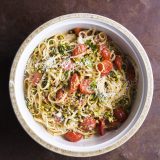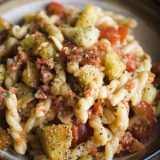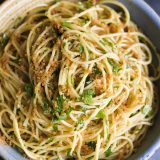Glistening and splayed on the road, the 280-kilogram tuna lay amid the evening scrum—a dusky piazza tumbling with chattering nonnas, couples on promenade and children punting soccer balls. It was dinnertime in Borgo Vecchio, Palermo’s oldest quarter. I’d come for Sicily’s simple, on-the-table-in-minutes pastas, but first the tuna had a lesson to teach.
At the center of the square, a young cook stood sentry over a long grill of coals he fanned with a wooden pizza peel. Over the embers, rough-cut tuna steaks, sizzling and billowing as he sloshed them with olive oil and lemon juice, the piazza filling with savory and smoke.
It was unregulated, unauthorized and almost certainly unsanitary. I was all in. For €9 (about $10), the fishmonger hacked me two robust steaks from the tuna, directing me to carry them to the cook. Another few euros earned my steaks a spot on the grill, along with generous splashes of vinaigrette. For bread, I was sent to Santarita Panificio, the bakery across the street. For wine, the supermercato next to it. For plastic cups and the loan of a corkscrew, the bar opposite the square (a bargain at €1).
The meal merged on a shaky plastic table under a darkening sky, laundry flapping from clotheslines above. The tuna—utter simplicity, utterly delicious. The barest of ingredients, flavors heightened but unmasked. It was rich and meaty, balanced by sweet, clear lemon, a lesson that trailed me across a weeklong circumnavigation of the island.
In Sicily, the nuts and sweets of North Africa long ago married the richness of classic Italian cooking, producing a cuisine where ingredients are combined sparingly to create brightness, ever blending sweet and savory. I’d come to find two easy pasta dishes I’d heard brokered that balance. I didn’t realize a third would find me.
My exploration of Sicilian pastas began in Castelbuono, a hilltop town in northern Sicily. Vincenzo Ippolito and his wife, Maria Enza Arena, welcomed me to a dayslong feast fueled by homemade wine decanted from an ancient barrel in a shed. It began in their outdoor kitchen overlooking fog-filled valleys—a local shepherd kicked it off with 40 liters of raw goat milk he transformed into three varieties of fresh ricotta over a bonfire in an old washing machine tub—and ended with a pasta-making lesson in the summer home of a friend down the mountain.
That friend, Benedetto Giacalone, a military police officer, used oxen hands to mash semolina flour, water and salt into a supple dough that the rest of us rolled, stretched and pressed into a pea pod-shaped pasta called gnocchi cavati. Indentations made by our fingertips formed tiny basins to capture pesto Trapanese, a raw tomato sauce from Trapani, Giacalone’s seaport hometown in northwestern Sicily.
Like the tuna, the pesto—once reserved for Sunday dinner—was a study in simplicity. Giacalone finely grated a handful of garlic cloves into a large wooden mortar, then used a pestle to mash them with coarse salt to form a smooth, wet paste. A handful of chopped grape tomatoes and more mashing. This pulpy-garlicky mix was then stirred into a large bowl of chopped tomatoes and torn fresh basil. Olive oil for peppery bite and richness, and the sauce was done.
Separately, coarse breadcrumbs were lightly toasted with olive oil, then set aside. The final ingredient, a flourish I would see over and again in Sicily: nuts, toasted and crushed. We used almonds that day, though the pistachios for which Sicily is known are also common. When the pasta was cooked, it was added to the tomatoes, steam lifting aromas of garlic, basil and sweetness as it was spooned into bowls. Breadcrumbs and almonds were sprinkled over each serving, creating a dish at once raw, rich and sweet, tender and crunchy, an almost instant sauce that was bold, fresh and bright.
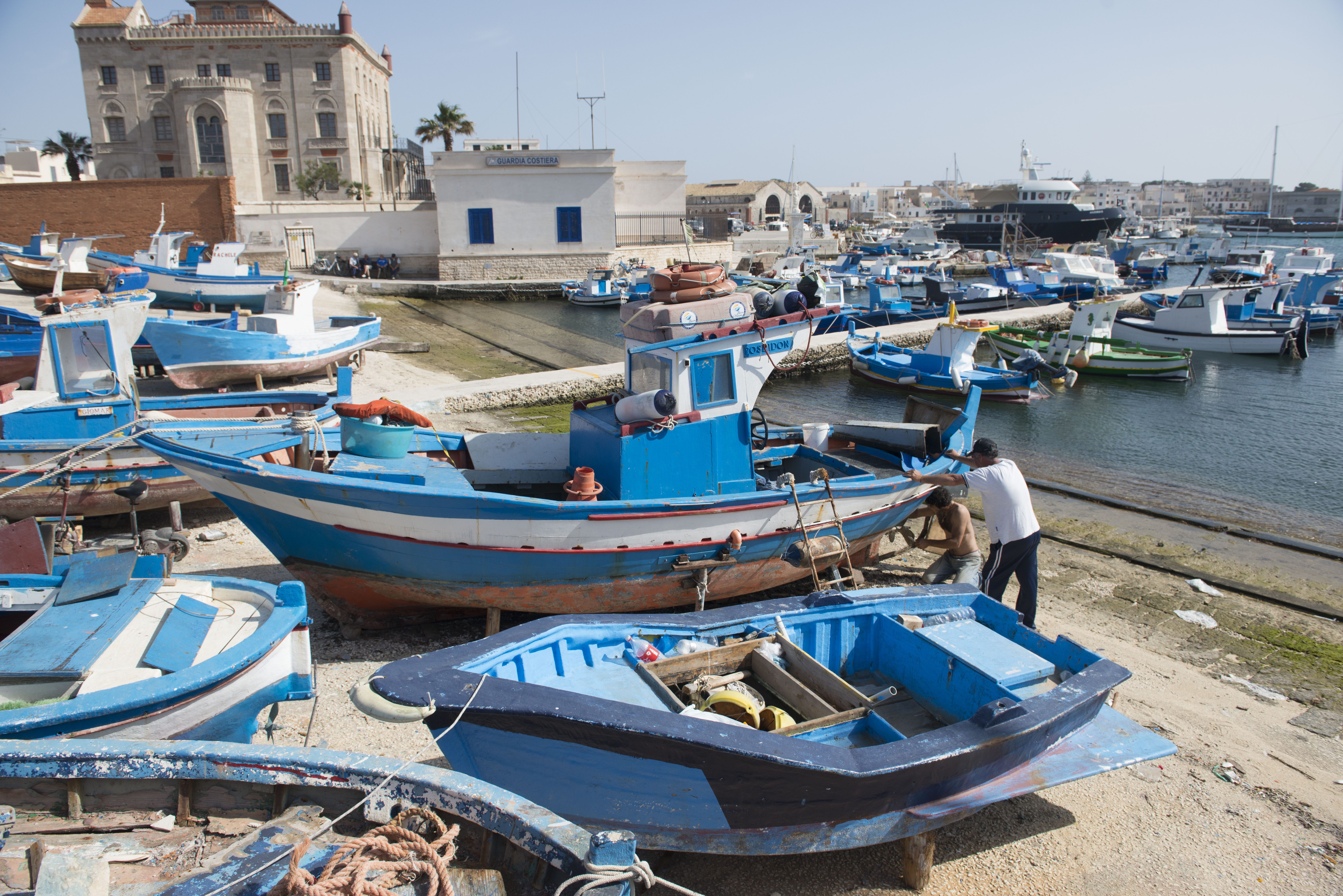
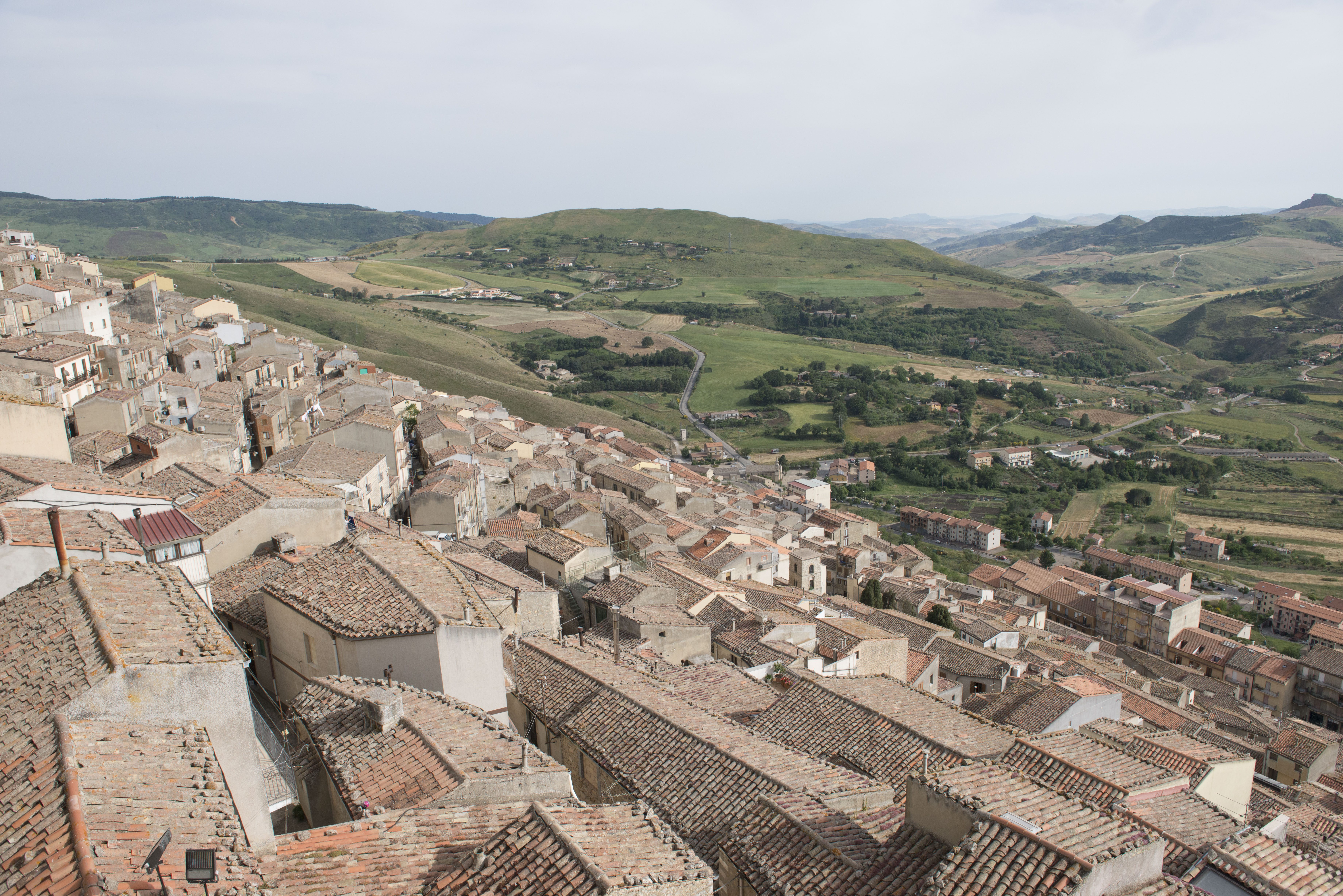
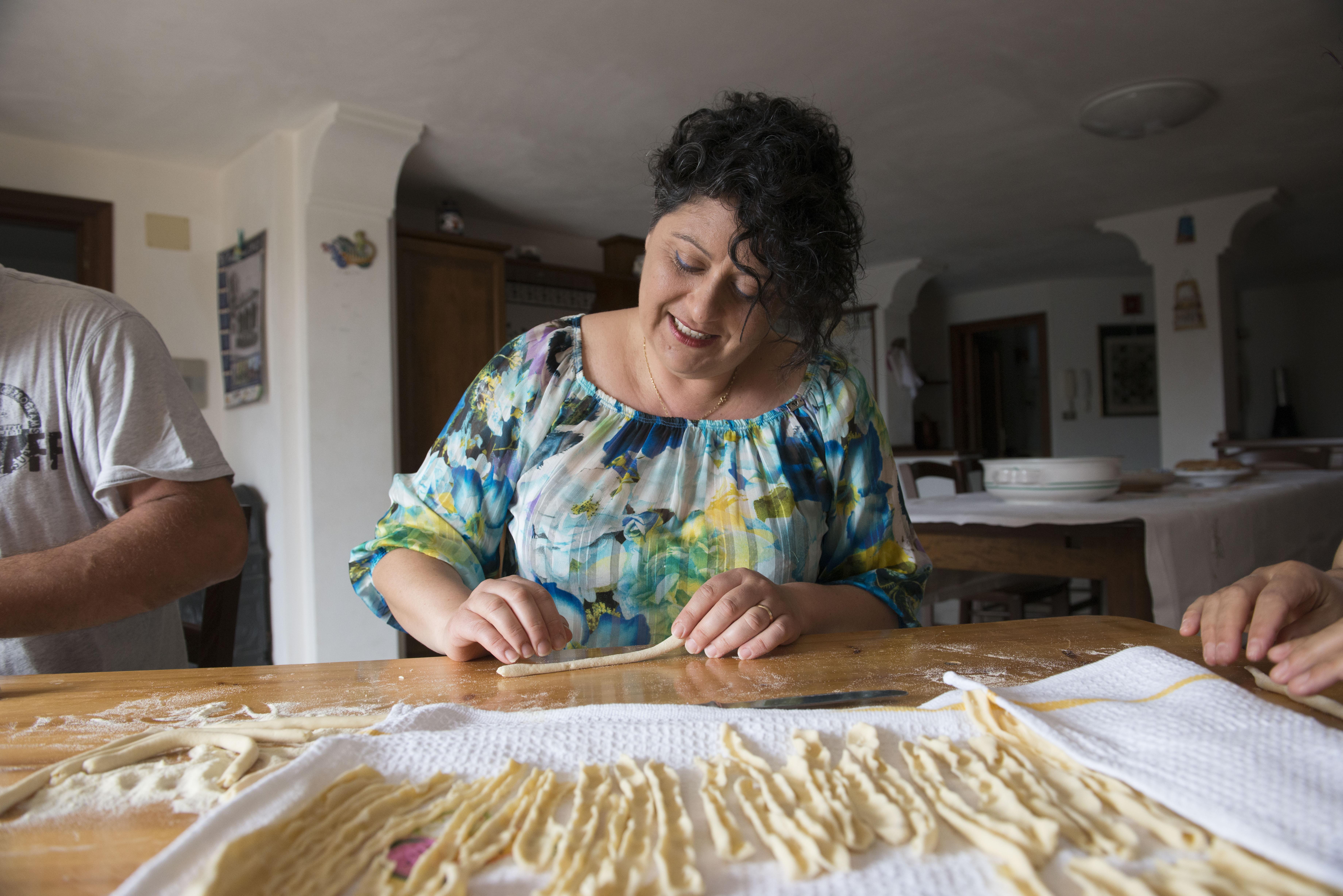
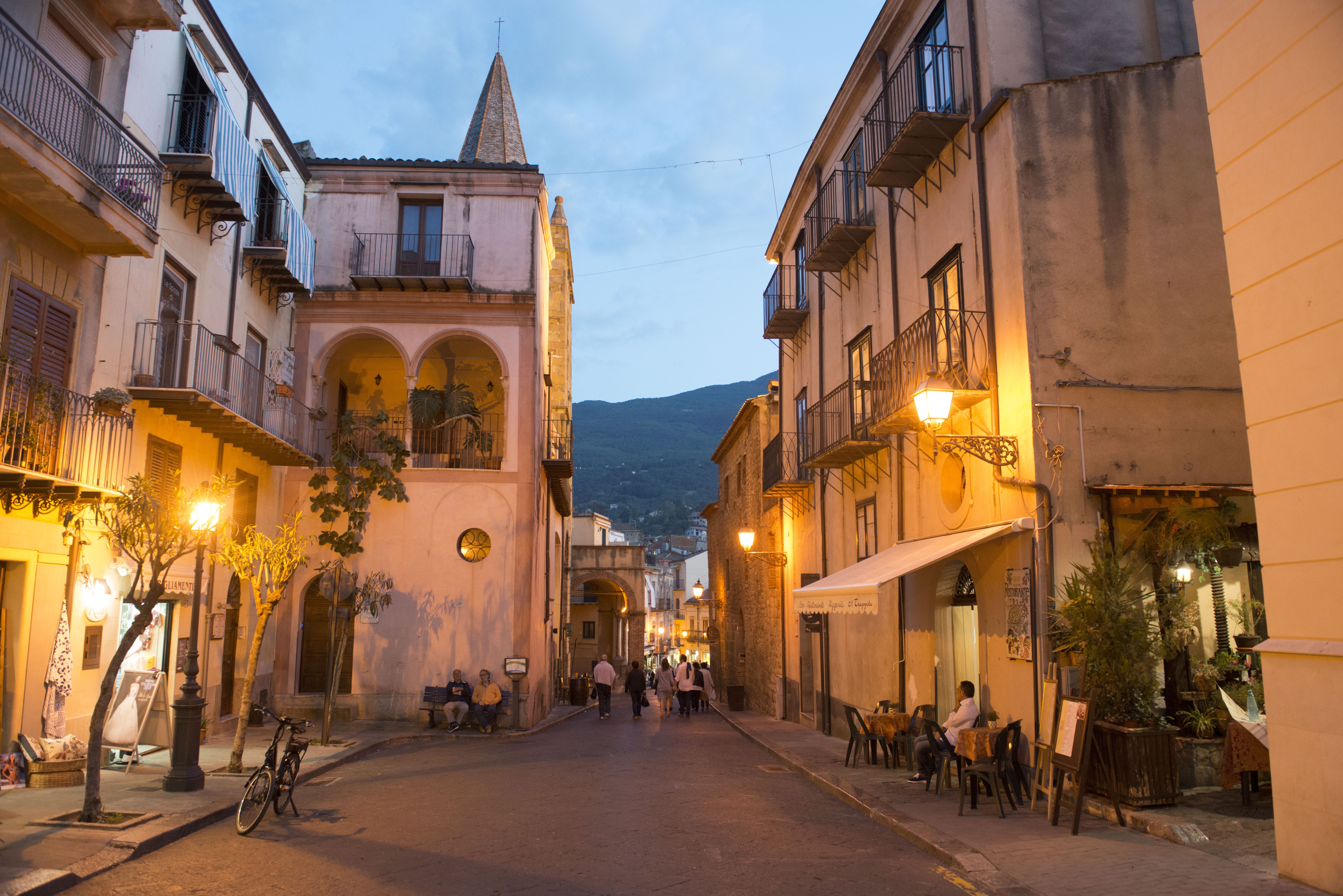
While all this was happening, Giacalone’s wife, Lea Venturella, focused on sarde a beccafico, a side dish I was certain never would make the pages of Milk Street. Working at the other end of the long table—closer to where a television shared space with a pizza oven—she made a mash of chopped raisins, pine nuts, garlic, parsley, breadcrumbs and olive oil, which she stuffed into filleted sardines, rolling them into tight bundles and snugging them into a pan. After baking, they were delicious—that same Sicilian sweet-savory-tender-crunchy—but also daunting. Raisin-stuffed sardines? That’s a hard sell.
Not knowing that dish would dog me, I headed three hours southeast—wending past smoking Mount Etna—to Sicilia in Tavola, a stone-arched trattoria in Siracusa. Owner Doriana Gesualdi offered to teach me a similarly simple and bold—but this time warm—sauce of pistachios, tomatoes and little else. “We don’t use garlic because we want you to taste the pure pistachios,” she explained.
In minutes—less time than the pasta cooked—chopped grape tomatoes were reduced to a sauce in a skillet of sizzling olive oil. A splash of starchy pasta cooking water first loosened, then thickened them. Coarsely ground pistachios mixed with olive oil went in next, simmering and reducing. Next, the pasta—plump ricotta-stuffed ravioli. Onto the plate and topped with more crushed pistachios, all in under 10 minutes. There it was again—a simple, sparing mix that nonetheless produced pronounced flavors and textures. Sweet tomatoes and rich, savory nuts created an almost creamy sauce, the latter also offering crunch to offset the tender pasta.
Gesualdi also wanted to show me something unhelpfully named pasta Siracusa. Turned out to be the local version of a dish known as pasta con le sarde, or pasta with sardines. While much of Sicily dines eagerly, frequently on sardines, in Siracusa they favor the poor person’s alternative—briny-savory anchovies. And so, garlic and anchovies browned and melted in sizzling olive oil before being tossed with pasta, breadcrumbs and parsley. Deliciously crunchy and rich, yet light. Again, on the table in minutes.
There was something familiar about this, but understanding it took another 500 kilometers around and up the southwestern side of Sicily, returning to Palermo. There on the fringes of Vucciria Market—a neighborhood still pockmarked by WWII wounds and rough enough to be skipped by tourists—I was pulled into the kitchen of Vecchia Trattoria da Totò. Husband and wife Giuseppe and Piera di Noto offered a signature dish: pasta Palermitana.
Piera deftly and speedily combined garlic, anchovies, pine nuts and raisins in a skillet of hot olive oil, cooking them until the fruit plumped and the anchovies melted. Pasta was added and tossed until richly coated, then dusted with coarse breadcrumbs. Another 10-minute dish that tasted of hours. The tender raisins added pops of sweetness against the salty anchovies and pungent garlic. And again with the nuts and breadcrumbs for texture. That’s when it struck me. This was a more elaborate version of Gesualdi’s pasta Siracusa. Strike that. Both of them were Venturella’s stuffed sardines recast as an easy pasta dish.
Beyond sheer simplicity, the trio of pastas had a common thread: nuts. Sicilians use them liberally for texture and richness to balance sweet ingredients like tomatoes and raisins. Adapting them at Milk Street was easy.
We loved the contrasting textures of crushed and chunked tomatoes in Giacalone’s pesto Trapanese, but streamlined using a food processor, adding some tomatoes first, the rest later. We also liked the richness of adding some of the almonds to the processor with the garlic and salt.
Gesualdi’s pasta with pistachio-tomato pesto was equally simple. We followed her recipe with few exceptions, adding fresh mint and lemon zest for their bright, fresh flavors. We also added a savory sprinkling of grated Parmesan or pecorino Romano cheese.
Likewise, the pasta Palermitano (or Siracusa, as you like). We mostly stuck with Piera’s recipe, though we liked more anchovies. We balanced the salty richness with white wine vinegar, a combination in keeping with Sicily’s love of agrodolce, a sweet-and-sour vegetable sauce.
Deliciously simple, though perhaps lacking the romance of tuna grilled in the street. Then again, I later heard that a similar feast the same night a few piazzas away left several people hospitalized. So maybe pasta is the better choice.
